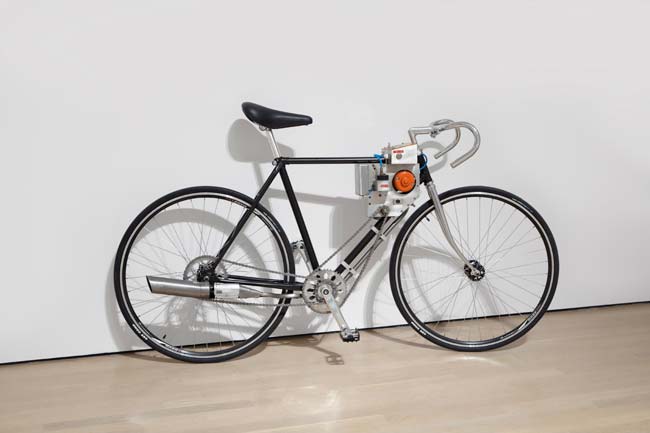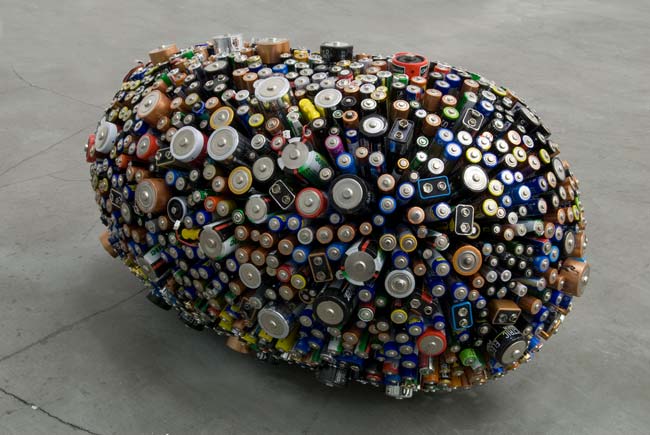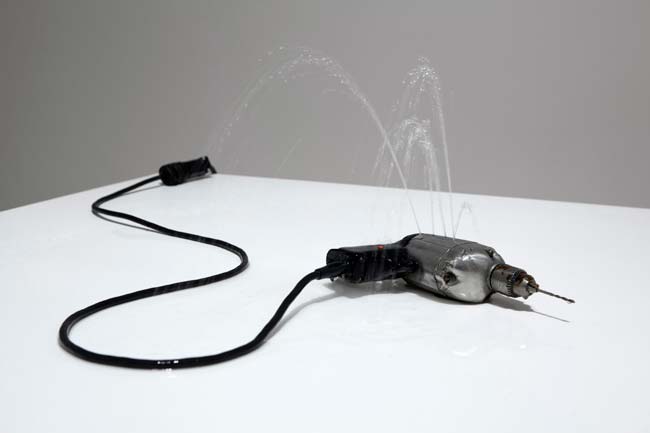Danger awakens the senses: An interview, Oli Sorenson
MKOS
Montréal based artist Michel de Broin is currently showing his solo exhibition at Musée d’art contemporain de Montréal. Despite his initial proposal to destroy the entire museum façade being declined, De Broin showcases an engaging selection of re-made works from the past two decades, intertwined with new commissions. Throughout his career, De Broin has questioned the visual systems that control our daily activities by transforming existing or discarded objects into things that often appear absurd, by playfully shifting and subverting our perceptions. From water bottle rockets to gigantic disco balls, his adventurous impersonations of the flawed inventor or engineer further pushes the boundary of what we consider alternative forms of art. De Broin talks to M-KOS about his work and his take on showing within high profile art institutions.
MKOS: Is it true you only had one year to plan this show ?
Michel de Broin [MdB]: Yes, it was a pretty fast turnaround. If I had needed any funding for this show [from the Canadian Art Councils], I would not have had enough time to submit for it. So this is what led me to work with existing pieces, from which I added new works that I wanted to produce. This year I already had a lot of projects underway, so it was a really busy time and when this show was proposed to me, I had the choice to accept or refuse it, opportunities like this happen maybe because there was a cancellation in the programming, and the museum people thought I would surely find a way to work it out.
MKOS: So you took the opportunity.
MdB: Yes, but the thing is, even if I had two years [to organise this show] I don’t think I would have done it better. It was good to do it quickly now because as an artist from Quebec, a solo exhibition at the Museum [of Contemporary Art of Montréal] is almost like the culminating event of your career. But this didn’t happen to me because for the past ten years I wasn’t based in Montréal, I moved around and made a bunch of projects around the world. This opportunity made me see this museum show more as a new cycle. For me it was a time to put together and assess my works, to solidify a few loose ends, produce a catalog, and then leave again.
MKOS: Was this assessment done with works you produced over the last decade?
MdB: The earliest piece is twenty years old, and a third of the works are new. The new ones are the largest, but when I first agreed to do this show I didn’t know if I could have done those. In the end, the show became quite saturated. There are lots of stuff filling the space. And it’s pretty funny because it does feel like a museum exhibition. Like in a group show, all the objects occupy their own space and use all types of media. There are pieces on the wall, others are free standing and there’s a willingness to represent all means of expression. But I think it is interesting to see how these pieces speak to each other, how they are connected together, not in a narrative or chronological way, not even according to a theme. Each piece builds on an internal logic, but these are also interesting in the way they respond to one another.

Reparations, 2009
MKOS: But the dialogue between the works is not sequential…
MdB: No. But a lot of stuff needed to be redone, and some pieces were too large or ephemeral to enter the museum, so for these instead we only displayed documentations, and that also made for different kinds of dialogues. And in terms of showing in a museum, you need to follow a certain protocol. You need to come up with the works’ titles and dimensions about six months before the opening. You must know what you are doing, so it’s easy to say “I’m showing this because I’ve done it before”. But some pieces were not so finely tuned because some parts were missing, and others needed to be redone from scratch. I had not realized the amount of energy and work involved in remaking some of the pieces. For example, some were disassembled and stored somewhere in a flooded basement in Berlin. But I’m glad I re-did them, even though it was a lot of work. And the energy in making them was different because I had assistants to help me. It is easier to redo works with an assistant than to do it on your own.
MKOS: Is it because you had to formalise the workflow for your assistant, rather than keep an intuitive process when working alone?
MdB: Maybe. But the works that were produced with my assistant went really well. Otherwise, some works like “La Maîtresse de la Tour Eiffel” (2009) are presented more as video documents, four monitors assembled in a column offer four points of view of that piece. I hung this piece in the Paris sky, a seven and a half metre diameter disco ball suspended from a huge sixty-metre high crane. It occupied a considerable amount of space, and presenting a document allowed to provide a glimpse of what this project was all about.
MKOS: The layout of the monitors in a column also adds to the verticality of this work.
MdB: Yes, and the way the disco ball is illuminated by sky search lights is inspired by an incredible picture called “The Battle of Los Angeles”, a battle that could have happened at the beginning of the First World War, where anti-aircraft lights are pointing to an unidentified object, and all kinds of guns are firing in its direction, with sparks, explosions and fireworks all around. There’s really no explanation for this image, some people think it was an attack by the Japanese, or a Martian invasion, or even a lost weather balloon. So that image and my subsequent work represent a lighting up of the sky, which I think ties in well with other works in the same room, like “L’Étendue de l’Abîme” (2013) which is a cyanotype, a process involving the light of the sun, and also “Réparation” (2004), another video archive of an intervention where I walk around the streets of Paris, shooting plastic bottles into the sky like a rocket, by compressing air and water into them with a homemade pumping apparatus, looking slightly like a war machine.

Keep on smoking, 2009
MKOS: There’s a really dissident side, irreverence within your work, which is also very tongue-in-check, a humour akin to early twentieth century, it seems.
MdB: The link to the 19th century in my art is most striking, I think, in the 16mm film I made with my staircase structure piece, or another one called “Keep On Smoking” (2005) which also reminds of early 20th century industrial pollution. In the case of the stairs, it’s also about the discovery of Eastern thought, Nietzsche and Schopenhauer, the idea of an eternal return. The texture of the film makes us think it was made 100 years ago. Un-coiled and laid out flat, the filmstrip in the projector is of the exact same length as the stairs. Both measure 100 feet, and both are in a loop.
MKOS: The stairs seem to draw the figure of infinity
MdB: Yes, but they also look like celluloid film, with its small perforations, its cells, it really reminds of how the film unfolds. I thought these details were all too obvious.
MKOS: And people walking on the staircase are like playback heads?
MdB: Yes, quite. The people on the staircase are 12 security officers, in charge of security at the contemporary art biennial [of Rennes, France, 2010]. The security guards were funny in their uniforms, which is a bit more chic than the ones here in Montréal. The French make more of an effort, with their earpieces and Men-in-Black look. I simply asked them to act as if they were working, to walk around without interacting with each other. Hiring people to play themselves is a much more efficient way to make a film than to hire professional actors. They have done it all for free, taking pleasure in participating in an art project, a pleasure only security guards are able to enjoy.
MKOS: Let’s talk about this process of accumulation we see throughout your work: tables, batteries, pickaxe heads, they accumulate in a surplus of objects, but they also seem to produce an accumulation of meaning which cannot be contained within the aesthetics of the resulting images.
MdB: This is one of the strategies I use. Some works use several strategies, but in the works you mention, it is the main strategy I use and I’m glad that you’ve reminded me. But effectively, the batteries are accumulated together, and as a battery is a device to accumulate energy, we can anticipate the charged energy, even if the batteries [in my work] are actually dead.
MKOS: They remain a symbol of accumulated energy.
MdB: That’s it. And it’s the same for the pickaxe heads, they are really like a funeral monument, they show several lifetimes of work, the lives of hard labour. This is a piece that I made from a picture I took in an Eastern European foundry, where they fabricated pickaxes and stock piled them like this on the ground.

Deadstar, 2008
MKOS: It’s almost a readymade.
MdB: Maybe not a readymade because these aren’t the actual pickaxes. I carved three pickaxe heads myself, modelled from the picture [in the foundry], so it’s a complete process of fabrication. We are always more or less doing readymades, you cannot escape the painter and his tubes of paints, like Duchamp has explained it well. But there is pleasure in going further to manufacture [new objects], because the distance with the originals is bigger, even Duchamp agrees that what is interesting is in the displacement. I find the more we are in the process of production, the more we create displacements. Plaster powder mixed with water allowed me to generate these shapes, then to work on the patina, all that led to a game of displacement, and into the pleasure of making.
But at the narrative level, there is this idea of accumulation that is reminiscent of the Paris catacombs. With the tables showing their undersides (“Tortoise”, 2012) I like the idea of showing what is under the table, where suspicious things are done. You can imagine a metaphor for the black market. Here all the tables are revealed, showing their underside, but to form an interior space. I was inspired by the turtoise, a Roman military formation we remember seeing in Asterix comic books: Romans using their shields to form a human, mobile architecture. Here the architecture is made of furniture, interior design becoming exterior, these are relations I like to play with.
MKOS: There are also some pretty dangerous looking things featured in this exhibition, at least that we perceive as dangerous, like a drill soaked in water (“Bleed, 2009) still connected to its electrical plug.
MdB: Indeed, and the plug also activates the drill’s fountain system. If you unplug it, the fountain stops working. I also like to permutate conventional energy sources such as water with fire, or water with electricity. These are all flows, they all have something in common.
MKOS: They also carry an affective charge.
MdB: That’s it. Sure there is a play with affects, and that’s a challenge when working in a museum with these issues, because museums are still highly protected place, as are more and more public spaces are invaded with security personnel, these days. We are living in a time of obsessive health and safety, but certainly danger is what awakens the senses.
MKOS: You said earlier this exhibition is not a culmination, but a transition to something else, so what’s next?
MdB: I have several upcoming projects, but they are in continuity to this one. The idea was to say that this exhibition came around quickly, but also it gave me a boost of energy to then immediately embark on my next project. I can’t tell yet what shape they will take, I still have all sorts of issues to resolve, but I am working on a pretty funny public art project in Charlottetown, and another big thing at the Reichstag in Berlin, as well as for Luminato [Festival] this summer in Toronto, where I’ll present the disco ball again.

Bleed, 2009